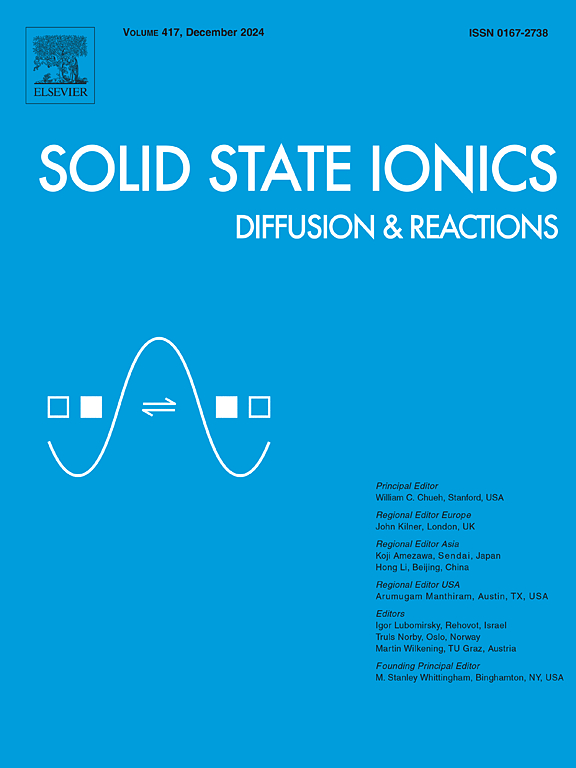液相氧化法制备镍锰复合氧化物及其在高压LiNi0.5Mn1.5O4合成中的性能研究
IF 3.3
4区 材料科学
Q3 CHEMISTRY, PHYSICAL
引用次数: 0
摘要
尖晶石型锂镍锰氧化物(LiNi0.5Mn1.5O4)因其工作电压高、安全性高、成本低等优点,近年来成为锂离子电池正极材料领域的研究热点。本研究采用液相氧化法制备了一种新的锂镍锰氧化物前驱体——镍锰复合氧化物,并通过高温煅烧合成了正极材料。研究了不同原料配比对制备LiNi0.5Mn1.5O4的影响及其机理。考虑到乙炔黑在高压体系中容易发生热分解和电化学反应,导致降解和性能下降,选用Super C65代替乙炔黑作为导电剂,以获得更好的电化学性能。实验结果表明,当Ni/Mn摩尔比为1:25 .5时,所制得的镍锰复合氧化物结晶度好,具有Fd-3 m的空间基团结构,颗粒分散均匀,团聚性弱。当Li/M摩尔比(M = Mn + Ni)为0.51时,LixNi1-xO杂质相的形成和材料的极化明显改善。制备的LiNi0.5Mn1.5O4粒度均匀,八面体形貌清晰,相特征纯净。在电流密度为0.2C时,初始放电比容量达到135 mAh/g,循环200次后保持在118 mAh/g。用Super C65代替乙炔黑后,LiNi0.5Mn1.5O4在0.2C下的初始放电比容量提高到140 mAh/g,循环200次后放电比容量达到122 mAh/g,电化学阻抗从304 Ω下降到266 Ω。这是因为Super C65的粒径更小,可以嵌入尖晶石材料颗粒之间形成良好的导电网络,增加无序空间团簇结构的晶格参数,为离子提供更多的扩散路径,促进元素价态的快速变化,从而表现出更高的电子导电性。虽然循环滞留率略有下降,但整体电化学性能有所提高。本文章由计算机程序翻译,如有差异,请以英文原文为准。
Study on the liquid-phase oxidation preparation of nickel-manganese composite oxides and their performance in high-voltage LiNi0.5Mn1.5O4 synthesis
Due to its high operating voltage, high safety, and low cost, spinel-type lithium nickel manganese oxide(LiNi0.5Mn1.5O4) has become a research hotspot in the field of lithium-ion battery cathode materials in recent years. In this study, a new lithium nickel manganese oxide precursor, a nickel‑manganese composite oxide, was prepared using a liquid-phase oxidation method, and the cathode material was synthesized through high-temperature calcination. The effects of different raw material ratios on the preparation of LiNi0.5Mn1.5O4 and their mechanisms were investigated. Considering that acetylene black tends to undergo thermal decomposition and electrochemical reactions in high voltage systems, leading to degradation and performance decline, Super C65 was used as a conductive agent instead of acetylene black to achieve better electrochemical performance. The experimental results indicate that when the Ni/Mn molar ratio is 1:2.5, the resulting nickel‑manganese composite oxide exhibits good crystallinity and a Fd-3 m space group structure with uniform particle dispersion and weak agglomeration. When mixed with LiOH and subjected to high-temperature calcination, with a Li/M molar ratio (M = Mn + Ni) of 0.51, the formation of the LixNi1-xO impurity phase and the polarization of the material were significantly improved. The prepared LiNi0.5Mn1.5O4 has uniform particle size, well-defined octahedral morphology, and pure phase characteristics. At a current density of 0.2C, the initial discharge specific capacity reaches 135 mAh/g and remains at 118 mAh/g after 200 cycles. After replacing acetylene black with Super C65, the initial discharge specific capacity of LiNi0.5Mn1.5O4 at 0.2C increased to 140 mAh/g, with a discharge specific capacity of 122 mAh/g after 200 cycles, and the electrochemical impedance decreased from 304 Ω to 266 Ω. This improvement is attributed to the smaller particle size of Super C65, which can embed between the spinel material particles to form a good conductive network, increase the lattice parameters of the disordered space cluster structure, provide more diffusion paths for ions, facilitate the rapid change of element valence states, and thereby demonstrate higher electronic conductivity. Although the cycling retention slightly decreased, the overall electrochemical performance was enhanced.
求助全文
通过发布文献求助,成功后即可免费获取论文全文。
去求助
来源期刊

Solid State Ionics
物理-物理:凝聚态物理
CiteScore
6.10
自引率
3.10%
发文量
152
审稿时长
58 days
期刊介绍:
This interdisciplinary journal is devoted to the physics, chemistry and materials science of diffusion, mass transport, and reactivity of solids. The major part of each issue is devoted to articles on:
(i) physics and chemistry of defects in solids;
(ii) reactions in and on solids, e.g. intercalation, corrosion, oxidation, sintering;
(iii) ion transport measurements, mechanisms and theory;
(iv) solid state electrochemistry;
(v) ionically-electronically mixed conducting solids.
Related technological applications are also included, provided their characteristics are interpreted in terms of the basic solid state properties.
Review papers and relevant symposium proceedings are welcome.
 求助内容:
求助内容: 应助结果提醒方式:
应助结果提醒方式:


